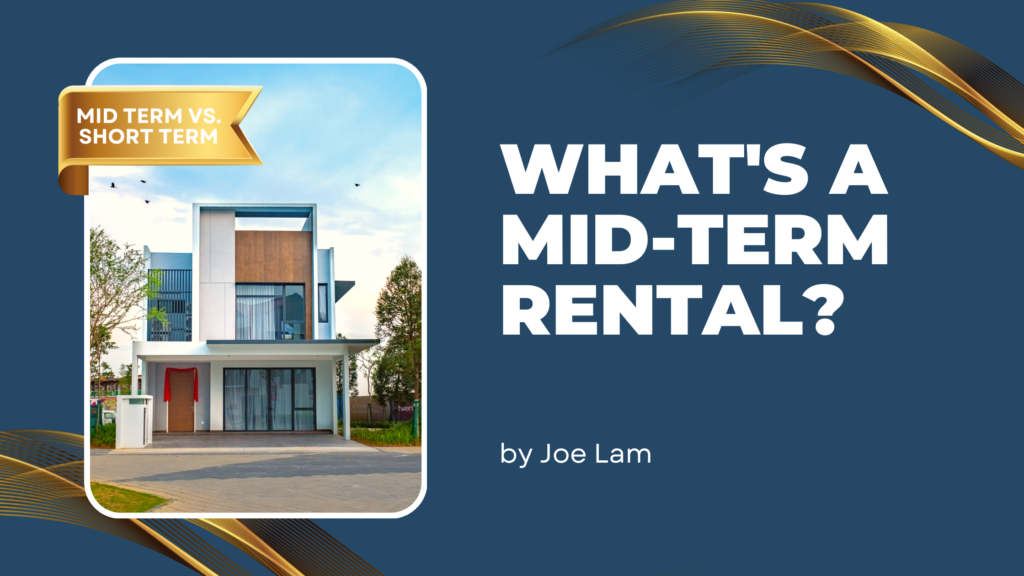Due to the popular growth of Airbnb renting, most people are aware of the term Short-Term Rentals, which is classified as a Guest staying in housing for less than 30 days. You’re probably also familiar with Long-Term Rentals, in which a Tenant signs a lease agreement for 1 year or more in a property that will serve as their primary residence.
However, did you know there’s another in-between rental category called Mid-Term Rentals? Mid-Term Rentals are classified
as a Tenant who receives housing between 1 to 12 months at a time. This serves as a great strategy to pivot into if the city you manage short term rentals tightens their regulations.
Managing a short-term rental can be a lucrative business. However, some major cities are cracking down on regulations to restrict short-term rentals, which can stifle business owners. At the time of this writing, some cities enforce a 90-day restriction on Short-Term Rental listings that are classified as “investment properties” where the Homeowner does not live in as a primary residence.
Other cities have enforced a regulation where the Homeowner must live on the same property where Guests stay by either renting out a separate Guesthouse unit on the lot or a single bedroom within the Main House. These limiting regulations can heavily restrict an individual from growing their Short-Term Rental business.
Hosts who violate this restriction will face steep fines upwards of $1,000 per day, which make operating a short-term rental on sites such as Airbnb.com, Vrbo.com, or Booking.con nearly impossible. Mid-Term Rentals, however, offer some great benefits as an alternative.
Mid-Term Airbnb Renting Benefits:
• When compared to a Long-Term Renter, Tenants are willing to pay a higher monthly amount for a property that’s fully furnished.
• Tenants require housing for 1 month or more, which means your occupancy rate is 100%, which often leads to a higher monthly income.
• When compared to a Short-Term Renter, your property will require less Guest communications and cleanings, which leads to more passive income.
• Tenants are typically professionals who are working remotely in industries such as Medical, Airline, Military, Construction, etc.
• Tenants are sometimes housed by their supervisors for temporary remote work, which means they will more likely be on
their best behavior and are less likely to throw parties or cause problems for your neighbors.
• Tenants still have their primary residence in another city or state, making it far less risky for them to squat in a property since they still have a home to return to.
Revenue Comparison:
Here is a comparison of monthly income earned between a Short-Term Rental and a Mid-Term Rental. I’ll use the national average for Short-Term Rental occupancy, which stands at 48%.
Day Rate at 48% National Average Occupancy:
$115 x 15 days = $1,725 per month
Monthly Rate at 100% Occupancy with 20% Discount:
$115 x 30 days = $3,450 – $690 (20% Discount) = $2,760 per month
As you can see, even with a 20% Discount, a Mid-Term Rental receives an additional $1,035 more revenue per month. Again,
there are also the added benefits of less communication since you’re only dealing with 1 Guest per month vs. 2-5 Guests during the same period, along with less scheduling of cleaning crews. This strategy allows you to earn both higher and more passive income.
Types of Mid-Term Renters:
• Students
• Military Personnel
• Medical Professionals
• Corporate Professionals
• Entrepreneurs/Business Owners
• Construction Workers
• Families who relocate while searching to buy a new home
Whether you’re planning to launch a new Short-Term Rental business or are already successfully managing your Airbnb renting one, consider the benefits of offering it as a Mid-Term Rental, especially if the regulation in your city makes it prohibitive.


